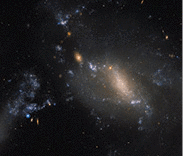Return to 4th Quarter 2018 articles.


One of my daily morning rituals is to go to my computer and click on apod.nasa.gov. APOD stands for Astronomy Picture of the Day. On that website, NASA features a picture taken from a space vehicle, a telescope on Earth or in space, or some system which allows us to see more of and learn about the cosmos. The pictures are amazing. Often they use different frequencies of light that our eyes cannot see to bring out the processes and products of the design of space.
So, sitting in my office, I can see things which bring to mind the words of “wisdom” recorded in Proverbs 8:
Does not wisdom call out? Does not understanding raise her voice? At the highest point along the way, where the paths meet, she takes her stand; beside the gate leading into the city, at the entrance, she cries aloud: “To you, O people, I call out; I raise my voice to all mankind. You who are simple, gain prudence; you who are foolish, set your hearts on it. Listen, for I have trustworthy things to say; …” (Proverbs 8:1-6) “The Lord brought me forth as the first of his works, before his deeds of old; I was formed long ages ago, at the very beginning, when the world came to be” (Proverbs 8:22-23).
It is easy to look at the wonderful pictures from outer space and miss the wisdom that those pictures convey. The website features comments about the pictures made by professional astronomers from around the world. It is hard to wrap one's mind around the vastness of space. While we see places where stars are being formed, we do not see the incredible number of design features required for those things to be possible. Consider some of these features:
VALUES OF FORCE CONSTANTS
In every basic physics class, students are introduced to the forces that are present in the creation. The equations that describe these forces are well known and can be verified in the lab. Gravity, for example, is described by the equation F = G (m1m2/x2). You can fill two large sandbags with sand and hang them next to each other, and they will be drawn together. M1 would be the mass of one sandbag and m2 would be the mass of the other sandbag. X is the distance between the sandbags. When you measure these quantities, you find that the equation works only if the value of G is 6.67 x 10 -11. That constant has to be precisely what it is or what we see in space could not exist.

By measuring the mass of the earth and the Moon and knowing the distance between them, we can calculate the force of gravity pulling the two bodies toward each other. If the value of G were less than 6.67 x 10-11 the Moon could not have the orbit that it does or it would fly off into outer space. If the value of G were more than 6.67 x 10-11, the Moon would crash into the earth. The universe that we observe depends on the gravitational constant being what it is.
This is just one of a large number of force constants critical to the existence of what we see through our telescopes. The electrical forces present in the cosmos are calculated by a law known as Coulomb's Law: F = K (q1q2/X2). The force between an electron and a proton can be calculated if you know their charges and how far apart they are. K is a constant and its value is 9 x 109. An electron and a proton have a huge force between them which is vastly greater than the gravitational pull between them. The strength of this force allows the electron to travel at incredible speeds around the nucleus of the atom without centrifugal force causing the electron to be thrown away from the atom or pulled into the nucleus.
There is a similar equation and constant for the magnetic force involved in atomic structure. Electrons are little magnets, so their magnetic values have to be carefully chosen, or chemical reactions would be impossible.
The nuclear coupling force also has to be carefully designed to allow a stable atom to exist. The nucleus of an atom is filled with protons which repel each other, and neutrons. The nuclear constants allow this seemingly impossible arrangement to work. All of these forces are just what a single, stable atom requires. If you were to assume that some chance process took place to produce energy that would turn into mass, all of these force constants would have to be in place.
THE SHAPE, NATURE, AND GEOMETRY
OF SPACE ITSELF
No matter what approach a person is making to the question of creation, ultimately the creation process has to invoke changes from dimensions outside of our familiar three-dimensional space. This is difficult for us to visualize because we live in an X, Y, and Z geometry. Even understanding the nature of time stretches our mental capacities. When science advances proposals like string theory, the equations that describe the cause of the cosmos involve other dimensions. In string theory, the equations indicate 11 possible dimensions.

The shape of space is critical to the existence of stable galaxies within the creation. If space had a spherical shape with a small radius, galaxies would be destabilized by gravitational interactions. If space were hyperbolic or parabolic with a small radius, any interactions between galaxies could not exist. Many of the pictures on the NASA website are of galaxies interacting and producing new stars as they do so. The curvature of space and its geometry allow for expansion and the continual production of heavier elements. Even black holes are tools of that production.
How far apart galaxies are and how far stars are from each other are critical factors for stable planets to exist. The fine structure constant which describes how stars and galaxies can exist is determined by Plank's constant, the velocity of light, and electron charge. Each of those constants must be precisely what it is for matter to exist.
Our understanding of how things we see in outer space are produced is still in its infancy, but it is evident that the size and pattern of galaxy existence are dependent on many things being exactly as they are.
THE DESIGN OF THE ELECTRON ORBITS
Electrons do not just orbit the nucleus of an atom in circular orbits. We now know that there are orbitals which describe how electrons travel. These orbitals are identified by the letters s, p, d, and f. S orbitals have two electrons and generally travel in a circular pattern. P orbitals have six electrons. They travel in dumb-bell shaped orbits or figure eights around the nucleus. Each p orbital is at right angles to the other two. D orbitals generally have 10 electrons that travel in an intricate pattern using all three dimensions of X, Y, and Z. F orbitals have 14 electrons.

These orbital patterns are connected to the magnetic fields of the electrons which are in turn connected to the spin of the electrons on their axes. An example of how this works can be seen in the oxygen atom which has eight electrons. The atom is designed so that the first four electrons are in s orbitals with two in each orbital. The next four electrons are in a p orbital which can hold six electrons. That means that there are two empty orbital positions in the oxygen atom. These two orbitals can accept one electron each. So an oxygen atom can bond with two other atoms to make a complete molecule. Water is H2O because two hydrogens fill in the missing electrons. That gives the water molecule a polar shape which allows the water molecule to dissolve other molecules.
Oxygen is a simple atom compared to carbon which has six electrons with two electrons in the p orbital. However, it is the presence of four spaces in the p orbital which allows carbon to produce so many compounds. Imagine the complexity of uranium with 92 electrons. It has taken the best minds of science literally centuries to understand how this design works and why it is superior to other geometries.
THE DESIGN FEATURES REQUIRED FOR
A PLANET TO SUPPORT ANY KIND OF “LIFE”
We put “life” in quotes because we are talking about the normal biological definition of life. Life is usually defined as “that which can breathe, move, respond to outside stimuli, and reproduce.” We are not talking about rock people or fire people or any of the other creations of science fiction.
The number of features that must exist has grown as we have looked at extra-solar planets. We now know that many planets have highly elliptical orbits. That arrangement produces extremes in temperature and radiation that would preclude any type of life. We also know that a life-supporting planet would require many things. It would need to be orbiting a star that is stable over the long haul and has the radiation emissions that would allow photosynthesis or chemosynthesis. The planet would have to be the right distance from a star that is located at a stable place within the galaxy (not near any supernovae or black holes).

In addition to the nature of the parent star, the planet itself needs a plethora of variables that must be carefully chosen to support life. Its distance from the star is critical. The perfect area is called “the Goldilocks zone” because it is not too hot or too cold for critical gases and water to exist in the proper state of liquid, solid, or gas. The inclination of the orbit also controls how much energy from the star the planet absorbs. The eccentricity of the planet's rotation controls the range of temperatures. The tilt of the planet on its axis controls the mixing of the gases in the atmosphere and the equalization of temperatures. The rotation rate controls the wind velocities and diurnal temperature differences.
In addition to those factors, having a moon of the right size and in the right place controls the water pattern on the planet which in turn controls climatic instabilities. The color of the surface of the planet controls its insolation (how much energy from its star the planet absorbs). Having massive oceans and dark colored land masses is critical for Earth to support life. The presence of a stable and strong magnetic field to shield the planet from charged particles coming from the parent star or charged cosmic rays is also critical as is the mass of the planet.
The planet's mass is important. If its mass is too low, it will lose its atmosphere or at least certain critical elements and gaseous molecules. If the mass is too great, toxic gases will be retained, and the atmosphere will be too thin to burn up meteoroids and asteroids. The atmospheric composition is important because clouds depend on the right gases and having the right types of clouds is critical to controlling albedo. (Albedo is a measure of how much light something reflects compared to what it receives.) If the albedo is large, a runaway ice-age develops. If it is too small, global warming produces a runaway greenhouse effect.

The percentage of oxygen in the atmosphere is vital not only for respiration of living things, but to control fires of all kinds on the planet. The thickness of the crust of the planet is vital because it controls tectonic activity on the planet. Having a protective shield of planets between the home planet and outer space with those planets having the right location and size is critical to avoiding bombardment by comets and other space debris. Having the proper ozone and carbon dioxide in the atmosphere controls the radiation levels on the surface of the planet. Having the proper compounds in the crust controls whether soils can exist that allow the proper diversity and complexity of life.
If your head is spinning thinking of all these requirements for a life-supporting planet, let me remind you that this list is not exhaustive. It contains only the most obvious values that have to be chosen by “wisdom” to allow a planet to exist that can support life. Proverbs 8 goes on to list many of these variables. It is also important to realize that any theory of naturalism or evolution assumes them.

Evolution has nothing to do with creation. It only proposes changes that may have occurred in living things once they were already created. When the Bible speaks of wisdom and knowledge in creation, it deals with actual creation. The wisdom and knowledge of God are seen and “The heavens declare the glory of God; the skies proclaim the work of his hands. Day after day they pour forth speech; night after night they reveal knowledge” (Psalm 19:1-2). “For since the creation of the world God's invisible qualities — his eternal power and divine nature — have been clearly seen, being understood from what has been made, so that people are without excuse” (Romans 1:20).
Note: A chart titled “Evidence for Design in the Universe” is available upon request, can be accessed at https://www.doesgodexist.org/Charts/EvidenceForDesignInTheUniverse.html.
Picture credits:
Cover: © Rawpixel.com. Image from BigStockPhoto.com.
© Rawpixel.com. Image from BigStockPhoto.com.
© Andrey Armyagov. Image from BigStockPhoto.com.
ESA/Hubble & NASA
© 7Gen_Grafik. Image from BigStockPhoto.com.
© Forplayday. Image from BigStockPhoto.com.
© pellinni. Image from BigStockPhoto.com.
© PathDoc. Image from BigStockPhoto.com.
Scripture links/references are from BibleGateway.com.
